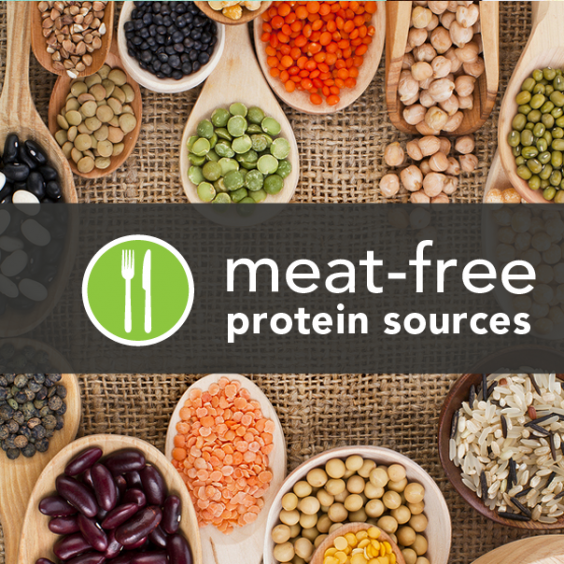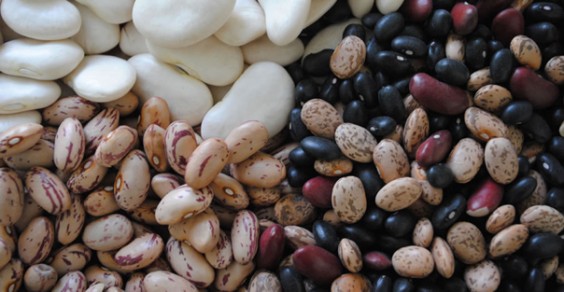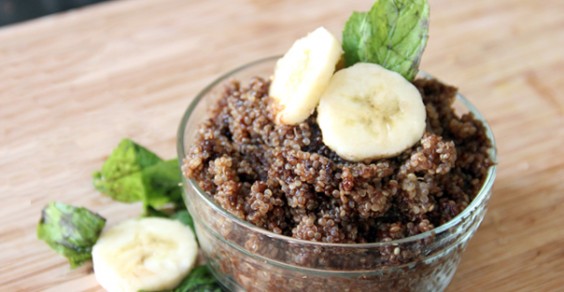
Across the country, people are choosing to eat less meat for the health of bodies and planet, whether for one meatless day per week or a lifetime. But those who work out regularly are (understandably) concerned about getting enough protein to keep those muscles well-supplied. The good news? Animal products aren’t the only source of quality protein. Here, we’ve rounded up seven animal-free alternatives so full of protein you might not miss the steak (but no promises).

Beans
Protein: About 7.5g per ½ cup* (varies slightly depending on the variety) Beans’ reputation precedes them: They really are a magical er, legume. These little superfoods are full of fiber, protein, and magnesium and are also low in cholesterol, making them an exceptional replacement for that sirloin. Beans of all kinds work best in soups, salads, veggie burgers, dips, and (of course) burritos.
Storage: Store dried beans in plastic bags or glass containers in a cool, dry place. It’s best to use dried beans within 12 months, or else they lose moisture and might require longer cooking times. Store canned beans (in original cans) in a cool, dry, dark space for up to a year. Cooked beans can be frozen for up to six months or refrigerated (in a lidded container) for up to five days.
Preparation (Dried): Before cooking dried beans, arrange them on a light-colored surface and sort through them, removing any dirt, tiny stones, and damaged or wrinkled beans. Next, it’s time for a rinse: Pour the beans into a large bowl and cover them with water. Before draining off the water, remove any “floaters” (they won’t cook properly). After draining, fill the bowl back up with cold water (at least three times more water than beans). Allow the beans to soak overnight (it’s normal for them to double in size during this time). In the morning, rinse and drain the beans three or four times, or until the water runs clear. Now they’re ready for whatever recipe your gut desires!
Preparation (Canned): Though they don’t afford the satisfaction of feeling like a homesteader, canned beans are a super convenient option since they’re pre-soaked and pre-cooked. But that doesn’t mean they don’t require some prep: Drain canned beans and rinse until the water runs clear before using them in recipes.
Tofu
Protein: 7g per ½ cup Perhaps the most famous meat-free protein, tofu is made from soybean curds (which makes it sound a lot less tasty than it can actually be). One of meat’s most versatile replacements, the spongy stuff can be baked, grilled, fried, steamed, sautéed, or eaten raw (it comes in soft, firm, and extra firm varieties, each of which is best suited to certain methods of cooking). Since it absorbs the flavor of whatever it’s cooked with (and doesn’t provide much pizazz on its own), tofu tastes best paired with bold- flavored foods (think onions, garlic, Swiss chard, curries and sauces, and — wait for it — even chocolate).
Storage: Tofu is typically sold in bricks, tubs, or tetra paks. In its unopened brick or tub packaging, tofu usually keeps for about a month in the fridge. Once the original package has been opened, any leftovers should be stored in water in a sealed container — this will keep it from going hard and will keep it fresh longer. Change the water once a day to maintain maximum freshness. Stored this way, leftover tofu can typically last a week or so. Unopened tofu tetra paks can be stored in a cool, dark, and dry cupboard or shelf and typically last for months or even up to a year.
Preparation: It’s pretty easy to make tofu at home. Raw tofu should be cooked or steamed before consumption, whereas store-bought tofu should be safe to eat uncooked (but as always, read package instructions). Before cooking with tofu, it should be “pressed” so the tofu can absorb maximum flavor during cooking. First, open the package and drain the water. Cut the tofu block width-wise into however many slices you want (4-5 usually works well). Lay out a dish towel on a flat surface (a counter, cutting board, or tray all work). Place some paper towels on top the dish towel, and lay out the tofu slices on top of the towels. Layer more paper towels and another dish towel on top of the tofu, then place a heavy object (ideally books or other flat objects) on top. Let the whole thing sit for 30 minutes (or apply some manual pressure to speed things along). Once the liquid has mostly drained out, get cooking!

Quinoa
Protein: 4g per ½ cup, cooked It’s a tiny little seed that’s gained tremendous popularity in the health-food world thanks to its giant health punch. One of the only grains and seeds providing the nine essential amino acids our bodies can’t produce on their own, quinoa deserves a spot on this list for being a complete protein. It’s also full of fiber, iron, magnesium, and manganese [1]. Most people are more familiar with the beige variety, but red and black quinoa are starting to show up on more grocery store shelves. The little seeds are a great alternative to grains or meat, and can be substituted for pasta, rice, and couscous or added to soups or salads for an extra protein boost.
Storage: Store uncooked quinoa in an airtight container in the fridge (for maximum longevity) or a cool, dry cupboard. Once it’s cooked, quinoa can last for a few days refrigerated in a covered container.
Preparation: Quinoa of any color is prepared much like rice. Some folks also like to soak it in cold water for a few hours or rub it between their fingers while rinsing in order to remove its coating, which can have a bitter taste. (Note: Some brands are pre-washed, so check the package when you purchase!) When it comes to cooking, most recipes and package instructions call for one cup of quinoa to two cups water. Bring the mixture to a boil, reduce the heat, cover, and simmer until the grains have become translucent and appear to have “sprouted” (aka they get a little white tail).
Seitan
Protein: 20g per ½ cup Also known as “wheat meat,” seitan (pronounced say-tahn) is made from wheat gluten (obviously, this one is not gluten-free friendly!). Chewier than tofu, the vegan meat alternative has a texture pretty similar to that of meat and absorbs the flavors of whatever it’s cooked with. The stuff isn’t very appealing when raw, but it can be baked, grilled, braised, boiled, or fried for a tasty substitute to meat.
Storage: To keep seitan from getting too chewy, it needs to be stored in liquid. If the seitan is homemade, just store it in the fridge in an airtight container with its own leftover broth. If it’s store bought, just use water. Stored this way, seitan should last for about a week in the refrigerator.
Preparation: It’s pretty easy to make seitan from scratch. All it takes is some vital wheat gluten, sauce, and seasonings. When it comes to cooking seitan, most recipes call for simmering the seitan in a broth before blending, grilling, baking, or cooking in whatever way the recipe indicates.

Lentils
Protein: 9g per ½ cup, cooked Yet another protein-packed superfood, lentils are high in folate, iron, potassium, and antioxidants, and they’ve even been linked to reduced inflammation [2] [3]. Lentils come in red and green varieties, and though their countenance might not be visually exciting, these legumes are a versatile protein source: Use them in soups, stews, salads, veggie burgers, dips, and nearly any type of Indian cuisine.
Storage: Like beans, lentils can be purchased in dried and canned forms, and the storage methods are virtually identical. Keep dried lentils in an airtight container in a cool, dry, and dark place for up to 12 months. Canned lentils can be stored in cool, dry cupboards for up to one year. Once cooked, lentils will stay fresh in the refrigerator (in a covered container) for about three days.
Preparation: Lentil prep pretty well mirrors that of beans (just skip the soaking). Before cooking, spread the lentils out on a light-colored surface and sort through for any dirt, tiny rocks, or damaged lentils. Next, rinse the lentils thoroughly (a strainer under running water works well), until the water runs clear. The easiest way to cook up these legumes: boiling water. Use three cups of liquid to one cup of lentils, and bring the water to a boil before adding the lentils and reducing the heat to a simmer and covering. Green lentils typically take around 30 minutes to cook; red lentils take around 20. If going the canned route, just give ‘em a good rinse before adding to your recipe!
Natto
Protein: 15.5g per ½ cup A popular Japanese breakfast staple, natto is derived from fermented soybeans and is similar in appearance to overgrown kidney beans. The texture tends to be chewy and a bit stringy, and the stuff is known for its “pungent” smell (to put it nicely). Most commonly eaten with sushi rice or in a maki roll, natto can also be used in baked goods, stir fries, dumplings, curries, and rice and pasta dishes. It’s difficult to find in the average U.S. grocery store, but for those willing to track it down in an Asian grocery, the protein payoff is mighty.
Storage: While shelf life can vary, it’s typically best to consume sealed packages within four to six weeks. Once open, leftovers will keep for a few days to a week in the refrigerator. As natto ages on the shelf or in the fridge, it’s normal for white specks to form — they’re the result of amino acids forming as the protein breaks down, and should be safe to eat. Natto can also be stored in the freezer in its original packaging (or some other container), and usually bounces back to its most edible form after defrosting for two or three days in the refrigerator.
Preparation: For the culinary adventurers among us, it’s possible to make natto from scratch by fermenting soybeans and adding probiotic cultures (a process that takes about 24 hours). For more carefree cooks, it can also be found pre-packaged in Asian grocery stores. Either way, it can be enjoyed raw or cooked. If cooking natto, be careful not to use high heat for more than a few minutes (it can cause the enzymes to break down and hurt the quality of the product).
Tempeh
Protein: 11g per ½ cup, cooked Made from fermented soybeans, tempeh is similar in texture to seitan and firmer and chewier than tofu. The nutty, slightly sweet flavor and crunchy texture is pretty good raw. But it tastes even better when it’s stir-fried, baked, steamed, broiled, seared, or grilled. Just like seitan and tofu, it tends to absorb the flavors of whatever it’s cooked with, making it a versatile alternative protein.
Storage: Tempeh can be found in the refrigerated and frozen sections of most grocery stores (in rare cases, it will be sold fresh). It can also made at home. Tempeh will stay fresh for several months in the freezer. It can also be stored in the fridge for up to ten days — simply toss it in a plastic baggie, saran wrap, or Tupperware.
Preparation: Fresh tempeh will need to be cooked for at least twenty minutes before it’s consumed (it’s always a good idea to read packages instructions if you’re unsure whether the tempeh you’ve purchased is fresh or pre-cooked). Pre-cooked tempeh (most commonly found in grocery stores) can be added raw to sandwiches or recipes, or cooked to change its texture and flavors.
nofollow link: Article Example
ReplyDelete